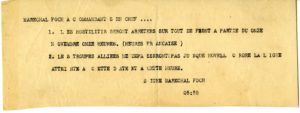Highlights of the World War I digitization project, part 2
Today I am continuing to share with you some of the great resources I have been able to digitize as a part of this World War I project.
I have been able to scan and share more details of individual soldier experiences through the letters and photographs of Northfield resident Homer Mason. Through Homer’s letters, we can learn from his experiences at training camp, traveling to Europe, and serving in the Signal Corps of the U.S. Army.

Homer Mason in uniform, St. Olaf College Archives. See it on the Collaborative.
Homer Mason, a 1918 graduate of St. Olaf College, enlisted in the United States Army on May 23, 1918 and was assigned to the Signal Corps. He learned how to operate radio and telegraph (or “buzzer”) machines, as well as to communicate with visual signals – all strategies to send and receive messages for the Army. He was stationed at the 34th Aero Squadron Radio Division near Tours in France from August 1918 to January 1919.

Entrance to the flying field near Tours, France, where Homer Mason was stationed. St. Olaf College Archives. See it on the Collaborative.
As you might expect, Homer sent and received many letters to his family from his training camp at Fort Leavenworth as well as from France. St. Olaf College has a collection of his correspondence, and we have had the opportunity to share some of them with you all on the Collaborative. His letters eloquently describe life in the military, including the pride of serving one’s country, and the boredom that comes with waiting to come home. In a letter to his parents written shortly after he arrived at training camp, Homer wrote, “I miss both of you very much, but I am not home sick a bit because I think this is a great life + I am anxious to do my little bit for our country.”

Letter from Homer Mason to his parents, June 5, 1918. St. Olaf College Archives. See it on the Collaborative.
Part of his job as a corporal in the Signal Corps was receiving radio transmissions of news. On the eve of the signing of the Armistice on November 10, 1918, Homer was manning his radio station at Tours. He intercepted press reports telling of the delivery of the terms of the Armistice, and also received the notice for the cessation of hostilities from the French Commander-in-Chief Marshal Foch. It was such a momentous occasion that he sent copies of both of those communications to his family – luckily for us!

Excerpt from a press report received by Homer Mason in France on November 10, 1918. St. Olaf College Archives.

Communique in French from the Commander-in-Chief Marshal Foch ordering the cease-fire for November 11, 1918. St. Olaf College Archives.
In a letter from Homer’s mother, written shortly after the Armistice was signed, the Northfield reaction can be experienced in great detail. She wrote:
Dear Homer, this is a day after we got the news that the war was over, but yesterday I could not write, so many came in and then there was so much merriment and noise that you could not hear yourself think. The bells commenced to ring at 3:30 in the night we got up and lit up the whole house we knew what it meant and how glad and thankful we was. And after it got light the soldiers came and the band and after that all the school children with old pails and dish pans and anything they could make noise on.
Not all of Homer’s letters are uploaded yet, but the few that are offer an eloquent snapshot of what his life was like in the Signal Corps and how his family was impacted by the war, as well. You can see the first set of photos, letters, and postcards that are uploaded here. Check back soon to see more!

I have to thank you for the efforts you have put in writing this site.
I really hope to see the same high-grade content from you in the
future as well. In truth, your creative writing
abilities has motivated me to get my own blog now 😉